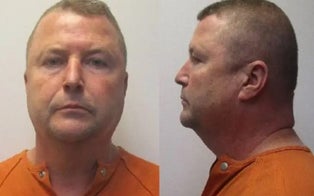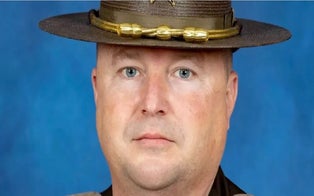Netflix looks at the strange case of "Confession Killer" Henry Lee Lucas.
By his own count, Henry Lee Lucas stabbed, strangled, shot, ran over or beat to death some 600 people, making him the world's most prodigious serial killer — or a pathological liar.
Hindsight favors the latter.
For years, Lucas told detectives he was a stone killer, amassing a body count of gigantic proportions. If there was an unsolved murder on Texas' crime logs, Lucas often claimed he had done it.
The latest cinematic look at Lucas, who became known as "The Confession Killer," debuts Friday as a five-part documentary series on Netflix. Co-directors Robert Kenner and Taki Oldham look hard at not only Lucas' long list of alleged victims, but also at his close dealings with law enforcement officers, who seemingly hung on every word of his copious confessions, while chauffeuring him to various sites where he said he hid bodies.
There have been four narrative films based on Lucas, beginning with 1985's "Confessions of a Serial Killer," 1986's "Henry: Portrait of a Serial Killer, Parts I and II," and "Drifter: Henry Lee Lucas" in 2009. Two documentaries were released in 1995.
But when Lucas died in 2001 of heart failure at the age of 64 while incarcerated, only three killings were definitively linked to him. One was the stabbing slaying of his own mother in 1960.
Again, by his own account, Lucas' childhood was the stuff maniacs are made of.
He was born in 1936 in Virginia, to an alcoholic and part-time prostitute who made her children watch while she had sex for money in the family's three-room, dirt-floor shack. His father was also an alcoholic who lost both legs in a drunken train accident. He died in 1949 after passing out in a blizzard.
His mother dressed him as a girl until the age of 7, he told investigators. He ran away in the sixth grade and drifted around Virginia. He claimed he committed his first murder in 1951, when he strangled a 17-year-old girl who rebuffed his advances. He later retracted that confession, something he did repeatedly over the years.
Lucas was convicted of several burglary counts near Richmond and was sentenced to four years behind bars in 1954. He escaped three years later, was recaptured, then released in 1959.
Four months later, while visiting his mother, who had moved to Michigan, Lucas argued with her over who was going to take care of her in her advancing years. He claimed she hit him with a broom. He retaliated by stabbing her in the neck. "She done pushed me beyond the limit of really caring," he told an interviewer. "I was just stretched to a point where I wasn't goin' to be pushed no further."
Lucas ran. He was later arrested and convicted of second-degree murder. He was sentenced to 20 to 40 years in prison, but released after 10 years because of prison overcrowding.
What followed were years of drifting, hitchhiking, accusations of sexual molestation and an arrest for unlawful possession of a firearm.
It was during that last arrest, in 1983 near Dallas, that Lucas began telling investigators about the murders he'd committed and gotten away with.
In all, his victim list surpassed 600 names and any number of heinous killing methods, including stabbing someone to death with a writing pen. His macabre confessions fueled media stories and broadcast interviews.
Watching him was not unlike being transfixed by a traffic accident — he had only one good eye and not many more teeth, making him repulsive and mesmerizing to TV viewers.
He had lost the sight in his eye, whose lid fluttered at half-mast, after his mother refused to get medical treatment for an injury he sustained during a childhood fight, he said.
As his list of confessed murders grew, expanding to hundreds of cold cases, a special task force was formed to investigate his claims.
Some 213 cases were cleared because of his confessions. And along the way, Lucas became something of a celebrity, signing autographs and posing for photos as he visited old crime scenes with authorities anxious to meet with him to discuss cold cases.
He received specially delivered milk shakes, restaurant meals and was able to spend vast amounts of time outside his prison cell.
That was, until his confessions started to fall apart with the advent of DNA testing and reporters for the now-defunct Dallas Times Herald, who meticulously investigated Lucas' alleged murders and discovered records that proved he was nowhere near the locations of many of the killings he claimed to have committed.
Law enforcement officials beat a hasty retreat. In 1986, then-Attorney General Jim Mattox of Texas said numerous killers remained free because investigators accepted bogus confessions from Lucas just to clear cases. He called the fake claims a "miscarriage of justice" and said it was "highly unlikely" Lucas carried out the hundreds of killings he took credit for.
In the end, Lucas had been sentenced to death for one murder he confessed to — the slaying of a Texas woman dubbed "Orange Socks" because her unidentified body was clad only in orange socks when it was discovered in 1979. George W. Bush, then the governor, granted clemency to Lucas over concerns about the confession, changing his punishment to life in prison.
On March 12, 2001, Lucas was found dead in his cell from heart failure. His grave is now unmarked because of vandalism and theft, authorities say.
"The Confession Killer" documentarians say they hope their new series helps to reopen murder cases wrongly attributed to Lucas, and to bring some sense of justice to the relatives of those victims.
RELATED STORIES






